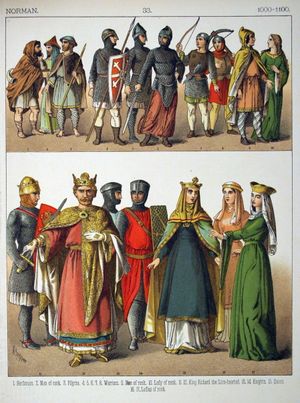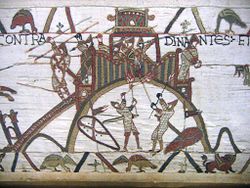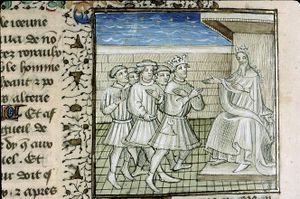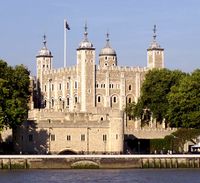نورمان
النورمان أو النورمانديون Normans هو اسم أطلقه الهولنديون والفرنسيون والألمان على شعب من أقدم الشعوب التي استوطنت الأراضي الاسكندناڤية، وقد عرفهم سكان الجزر البريطانية باسم آخر هو الدانس Danes. ويعني اسم النورمان رجال الشمال، وربما كانت اختصاراً قديماً متطوراً للكلمة الإنكليزية Northman.
أصل الكلمة
The English name "Normans" comes from the French words Normans / Normanz, plural of Normant,[1] that is itself borrowed from Old Low Franconian Nortmann "Northman"[2] or directly from Old Norse Norðmaðr, Latinized in Nortmannus (recorded in Medieval Latin, 9th century) to mean "Norseman" or "Viking".[3]
صفاتهم
11th century Benedictine monk and historian, Geoffrey Malaterra characterised the Normans thus:
Specially marked by cunning, despising their own inheritance in the hope of winning a greater, eager after both gain and dominion, given to imitation of all kinds, holding a certain mean between lavishness and greediness, that is, perhaps uniting, as they certainly did, these two seemingly opposite qualities. Their chief men were specially lavish through their desire of good report. They were, moreover, a race skillful in flattery, given to the study of eloquence, so that the very boys were orators, a race altogether unbridled unless held firmly down by the yoke of justice. They were enduring of toil, hunger, and cold whenever fortune laid it on them, given to hunting and hawking, delighting in the pleasure of horses, and of all the weapons and garb of war."[4]
Their quick adaptability expressed itself in the shrewd Norman willingness to take on local men of talent, to marry the high-born local women; confidently illiterate Norman masters used the literate clerks of the church for their own purposes.
Anna Komnene, the daughter of Byzantine Emperor Alexios I Komnenos, described the Norman prince Bohemund I:
Now Bohemund was such as, to put it briefly, had never before been seen in the land of the Romans, be he either of the barbarians or of the Greeks (for he was a marvel for the eyes to behold, and his reputation was terrifying). Let me describe the barbarian's appearance more particularly - he was so tall in stature that he overtopped the tallest by nearly one cubit, narrow in the waist and loins, with broad shoulders and a deep chest and powerful arms. And in the whole build of the body he was neither too slender nor overweighted with flesh, but perfectly proportioned and, one might say, built in conformity with the canon of Polycleitus... His skin all over his body was very white, and in his face the white was tempered with red. His hair was yellowish, but did not hang down to his waist like that of the other barbarians; for the man was not inordinately vain of his hair, but had it cut short to the ears. Whether his beard was reddish, or any other colour I cannot say, for the razor had passed over it very closely and left a surface smoother than chalk... His blue eyes indicated both a high spirit and dignity.
تصف المصادر المعاصرة معظم النورمان بأجسامهم الطويلة وعيونهم الزرقاء وأرديتهم ذات الألوان المتعددة، وبدائيتهم في التعامل مع بعضهم وميلهم إلى الفوضى، وحب القتال والقسوة على الأعداء، وحب التنقل وكرههم للاستقرار في مكان واحد وكذلك تكوين أسر، وغرامهم بالغزو من أجل السلب والنهب.
وتؤكد هذه المصادر أن النورمان عاثوا في المناطق التي غزوها بشكل لم تعرفه أوربا في عصورها الوسطى، لدرجة أن المجتمعات الأوربية تداولت عدداً من القصص التي حيكت عن جبروتهم وقسوتهم، كما ألّفت عدداً من المراثي عن ضحاياهم من الرجال والنساء، وعلى الرغم من أن عدداً من المؤرخين يعتقدون بتلفيق كثير من هذه القصص تبقى مرآة تعكس مدى الهلع الذي كان يسببه نزولهم في مكان ما في نفوس سكانه، ويبدو أن الديانة التي آمنوا بها والتي كانت تروِّج لفكرة أن القتلى في المعارك سيذهبون إلى ما يسمى ڤالهالا Valhalla وتعني «الجنة في الشمال» هي التي كرست في نفسياتهم هذه الطبيعة الميالة إلى العنف ومحبة رؤية الخوف في نفوس الأعداء.
يبدأ تاريخهم المدوَّن نحو سنة 795م، عندما بدأ قسم منهم يحملون لقب ڤايكنگ Vikings. وعندما بدأ استقرار إحدى قبائلهم التي قدمت من النروج في جزر فارو Faeroe واوركني Orkney في بحر الشمال تمكن أفراد هذه القبيلة من التسلل في القرن التاسع إلى روسيا وأوصلوا في منتصف ذلك القرن عدداً من أبنائهم إلى سدة السلطة في كل من نوڤگورود وكييڤ، في الفترة نفسها التي نجح قسم منهم في الاستقرار في جزيرة أيسلندا.
نورماندي
وفي العقود الأولى من القرن التاسع انطلق النورمان في غزواتهم من مناطق استيطانهم الجديدة كما القديمة، وهاجموا على طريقة القراصنة الشواطئ البريطانية والألمانية من دون المغامرة بالتوغل إلى الداخل، إلا أن الحكم المتراخي للملكين شارل (الطيب) وشارل (البدين) أغراهم بالتوغل في مناطق مصب نهر السين حتى وصلوا إلى باريس نفسها. ولم تتمكن عروض المال التي قدمها لهم الملك شارل (الطيب) من إقناعهم بالتراجع حتى نزل لهم عن مقاطعة نوستريا Neustria التي حملت اسم سكانها الجدد فيما بعد (نورماندي Normandie)، كما أقدم الملك شارل (البدين) على تزويج ابنته بـ الزعيم النورماندي المدعو Rollo الذي اعتنق المسيحية وأطلق على نفسه اسم الدوق روبرت فأصبح بذلك أحد أشراف المملكة الفرنسية.
الفتوحات
في إيطاليا

تركت إيطاليا الآن تعاني الانقسام والحكم الأجنبي مدى ألف عام، لن نعني بتسجيل تفاصيل حوادثها. وحسبنا أن نقول إن النورمان شرعوا في 1036 يفتحون إيطاليا الجنوبية وينتزعونها من الدولة البيزنطية. ذلك أنه كان من عادة أشراف نورمنديا أن يوزعوا أراضيهم على أبنائهم بالتساوي كما يفعل الفرنسيون في هذه الأيام، وكانت نتيجة هذا القانون في نورمنديا أن تجزأت أملاك الأسر في العصور الوسطى إلى ملكيات صغيرة على حين أن نتيجته في فرنسا هي وجود أسر صغيرة. ولم يكن النورمان راغبين في حياة الفقر الهادئة، وكانوا إلى هذا لا يزالون يذكرون ما طبع عليه آباؤهم أهل الشمال من حب المغامرة والسلب والنهب، ولهذا أجَّر بعض شداد النورمان أنفسهم إلى أدواق إيطاليا الجنوبية المتنافسين المتنازعين، وأظهروا ضروباً من البسالة في حروبهم إلى جانب بنفنتو، وسلرنو، ونابلي، وكبوا، وإلى جانب أعدائها، وأعطوا مدينة أفرسا Aversa جزاء لهم على أعمالهم وترامى إلى مسامع غيرهم من شباب النورمان المتحمسين أن الأراضي تكسب بضربة أو ضربتين من سواعدهم، فغادروا نورمنديا إلى إيطاليا. وسرعان ما أصبح من فيها من النورمان كثرة تستطيع أن تقاتل لحسابها، ولم يحل عام 1053 حتى أنشأ أجرأهم ربرت جوسكارد Robert Guiscard (أي العاقل أو الماكر) مملكة نورمندية في إيطاليا الجنوبية. وكان ربرت هذا يتصف بكل الصفات التي تخلعها الأساطير على الأبطال. وكان أطول من جميع جنوده، وكان قوي الساعدين، صلب الرأي، جميل المحيا، أشقر الشعر، أصهب اللحية، فخم الثياب، سخي اليد ينثر الذهب نثراً، قاسياً في بعض الأحيان، وباسلاً على الدوام.
ولم يكن روبرت يعترف بغير قانون القوة والخداع، فاجتاح كلابريا واستولى على بنفنتو، وكاد يمشي إليها على جثة البابا ليو التاسع (1054)، وعقد حلفاً مع نقولا الثاني، تعهد فيه أن يكون خاضعاً له وأن يؤدي له الجزية، وأقطعه نقولا في نظير ذلك كلبريا، وأبوليا Apulia وصقلية (1059). وترك ربرت أخاه الأصغر روجر ليفتح صقلية، واستولى هو على باري Bari (1071) وطرد البيزنطيين من أبوليا. واغتاظ إذ وجد البحر الأدرياوي يعترض طريقه فأمل أن يعبره ليستولي على القسطنطينية، ويصبح أقوى ملوك أوربا جميعاً. وأنشأ من فوره عمارة بحرية، هزم بها الأسطول البيزنطي في واقعة بحرية بالقرب من درزو (1081)، واستغاثت بيزنطية بالبندقية، فخفت هذه المدينة لنجدتها لأنها لم تشأ إلا أن تكون ملكة البحر الأدرياوي، وأوقعت سفائنها الماهرة في ضروب القتال هزيمة منكرة بعمارة جوسكارد البحرية في عام 1082 على بعد قليل من موضع نصره الذي ناله من وقت قصير. ولكن ربرت استطاع بنشاطه الشبيه بنشاط يوليوس قيصر نقل جيشه إلى دورزو Durazzo وهزم عندها جيوش الكسيوس الأول الإمبراطور اليوناني، واخترق إبريوس وتساليا حتى كاد يصل إلى سلانيك. وبينما هو يوشك أن يحقق حلمه إذ تلقى دعوة حارة من البابا جريجوري السابع يستغيث به لينقذه من الإمبراطور هنري الرابع. فما كان من ربرت إلا أن ترك جيشه في تساليا، وعاد مسرعاً إلى إيطاليا، وحشد جيشاً من النورمان، والطليان، والمسلمين أنقذ به البابا، وانتزع روما من الألمان، وأخمد ثورة قام بها الشعب على جيشه، وترك هذا الجيش الحانق يحرق المدينة وينهبها ويخربها تخريباً لا يجاريه فيها تخريب الوندال أنفسهم لهذه المدينة (1084) وعاد في هذه الأثناء ابنه بوهمند Bohemond ليعترف بأن جيشه الذي كان في بلاد اليونان قد مزقه ألكسيوس شر ممزق. وأنشأ القرصان القديم أسطولاً ثالثاً هزم به أسطول البندقية بالقرب من جزيرة كورفو Gorfo (1084)، واستولى على جزيرة
كفلونيا Cephalonia الأيونية، ثم مات فيها، بعدوى سرت إليه أو بالسم، في سن السبعين (1085). وكان هو أول القادة اللصوص في إيطاليا (الكندتيري Gonedottieri).
في بيزنطة
في إنگلترة
عانت بريطانيا مدة تصل إلى 200 سنة الدمار الذي سببته غزوات النورمان، واشتهر من زعمائهم كل من إگبرت Egbert (802-839) الذي بقي على وثنيته وألفرد الأكبر Alfred ت(871-899) الذي حقق النورمان في عهده وما بعده سيطرتهم على شرقي إنكلترا وشماليها، وتطورت هذه السيطرة في القرن الحادي عشر ليحكم ثلاثة نبلاء اسكندنافيين من النورمان معظم البّر الإنكليزي مدة خمس عشرة سنة وهم كانوت Canute وهارولد Harold وهاردي كانوت Hardi Canute، في الفترة نفسها التي تأسست فيها السلالة الساكسونية Saxon Line في إنكلترا، ولم يكتف النورمان بذلك بل عملوا سياسياً وعسكرياً للسيطرة على كامل الأرض الإنكليزية . وقد أفلح وليم دوق نورماندي في 14/10 سنة 1066 في الجلوس على العرش البريطاني نتيجة معركة هاستنگز Hastings التي تغلب فيها على الملك الأنگلو ساكسوني هارولد الثاني، وكان لهذا الحدث تأثير كبير في التاريخ الإنكليزي من النواحي الثقافية والاجتماعية والسياسية.
في أيرلندا

في اسكتلندا
في ويلز
نظرية اكتشافهم أمريكا
وتعزو بعض روايات النورمان إليهم اكتشافهم الساحل الأمريكي عندما أبحر الزعيم إريك Eric بن ليف Leif الملقب بالأحمر مع خمسة وثلاثين رجلاً من غرين لاند غرباً واكتشف أمريكا وأعطاها اسم ڤنلاند Vinland، وتابع رحلات الاستكشاف بعده من گرينلاند أيضاً الزعيم ثورفين كارلسفني Thorfinn Karlsefni بصحبة 160 رجلاً على ثلاث سفن ولكنها لم تحقق الهدف المطلوب.
في الحملات الصليبية
The legendary religious zeal of the Normans was exercised in religious wars long before the First Crusade carved out a Norman principality in Antioch. They were major foreign participants in the Reconquista in Iberia. In 1018, Roger de Tosny travelled to the Iberian Peninsula to carve out a state for himself from Moorish lands, but failed. In 1064, during the War of Barbastro, William of Montreuil led the papal army and took a huge booty.
In 1096, Crusaders passing by the siege of Amalfi were joined by Bohemond of Taranto and his nephew Tancred with an army of Italo-Normans. Bohemond was the de facto leader of the Crusade during its passage through Asia Minor. After the successful Siege of Antioch in 1097, Bohemond began carving out an independent principality around that city. Tancred was instrumental in the conquest of Jerusalem and he worked for the expansion of the Crusader kingdom in Transjordan and the region of Galilee.[بحاجة لمصدر]
الفتح الأنگلو-نورماني لقبرص
The conquest of قبرص by the Anglo-Norman forces of the الحملة الصليبية الثالثة opened a new chapter in the history of the island, which would be under Western European domination for the following 380 years. Although not part of a planned operation, the conquest had much more permanent results than initially expected.
In April 1191 Richard Cœur de Lion, with a large fleet, left مسينا in order to reach عكا.[5] But a storm dispersed the fleet. After some searching, it was discovered that the boat carrying his sister and his fiancée Berengaria was anchored on the south coast of Cyprus, together with the wrecks of several other ships, including the treasure ship. Survivors of the wrecks had been taken prisoner by the island's despot Isaac Komnenos.[6] On 1 May 1191, Richard's fleet arrived in the port of Limassol on Cyprus.[6] He ordered Isaac to release the prisoners and the treasure.[6] Isaac refused, so Richard landed his troops and took Limassol.[7]

Various princes of the Holy Land arrived in Limassol at the same time, in particular Guy de Lusignan. All declared their support for Richard provided that he support Guy against his rival Conrad of Montferrat.[8] The local barons abandoned Isaac, who considered making peace with Richard, joining him on the crusade, and offering his daughter in marriage to the person named by Richard.[9] But Isaac changed his mind and tried to escape. Richard then proceeded to conquer the whole island, his troops being led by Guy de Lusignan. Isaac surrendered and was confined with silver chains, because Richard had promised that he would not place him in irons. By 1 June, Richard had conquered the whole island. His exploit was well publicized and contributed to his reputation; he also derived significant financial gains from the conquest of the island.[10] Richard left for Acre on 5 June, with his allies.[10] Before his departure, he named two of his Norman generals, Richard de Camville and Robert de Thornham, as governors of Cyprus.
While in Limassol, Richard married Berengaria of Navarre, first-born daughter of King Sancho VI of Navarre. The wedding was held on 12 May 1191 at the Chapel of St. George and it was attended by Richard's sister Joan, whom he had brought from صقلية. The marriage was celebrated with great pomp and splendor. Among other grand ceremonies was a double coronation: Richard caused himself to be crowned ملك قبرص, and Berengaria Queen of England and Queen of Cyprus as well.
The rapid Anglo-Norman conquest proved more important than it seemed. The island occupied a key strategic position on the maritime lanes to the Holy Land, whose occupation by the Christians could not continue without support from the sea.[11] Shortly after the conquest, Cyprus was sold to the Knights Templar and it was subsequently acquired, in 1192, by Guy de Lusignan and became a stable feudal kingdom.[11] It was only in 1489 that the Venetians acquired full control of the island, which remained a Christian stronghold until the fall of Famagusta in 1571.[10]
وتذكر مصادر تاريخ البحر المتوسط قيام عدد من النورمان سنة 1016 بتأسيس مملكة جديدة في مدينة نابولي جنوبي إيطاليا، وقيام روبرت غسكار بن تانكريد Guiscard Tancrede وأخيه روجر Roger بإخراج المسلمين من صقلية سنة 1090 وتأسيس مملكة صقلية هناك، لكن تاريخهم بعد هذه الفترة يبدأ بالتضاؤل تدريجياً مع تضاؤل حجم توسعهم وتضاؤل قوتهم حتى اندثارهم تماماً.
الثقافة
العمارة
The Normans' architecture typically stands out as a new stage in the architectural history of the regions which they subdued. They spread a unique Romanesque idiom to England and Italy and the encastellation of these regions with keeps in their north French style fundamentally altered the military landscape. Their style was characterised by rounded arches (particularly over windows and doorways) and massive proportions.
الفنون المرئية

الموسيقى

الحكام
- List of Dukes of Normandy
- List of Counts and Dukes of Apulia and Calabria
- List of Counts of Aversa
- List of Princes of Capua
- List of Dukes of Gaeta
- List of Princes of Taranto
- List of monarchs of Sicily
- List of Princes of Antioch
- List of Officers of the Principality of Antioch
- Second House of Lusignan
- List of Kings of England
- List of Kings of Scots
انظر أيضاً
المصادر
- مفيد العابد. "النورمانديون". الموسوعة العربية.
- ^ T. F. HOAD, English Etymology, Oxford University Press Paperback, 1993. p. 315.
- ^ Albert Dauzat, Jean Dubois, Henri Mitterand, Larousse étymologique, éditions Larousse, 1971. p. 497.
- ^ "Etymologie de Normand". Centre National de Ressources Textuelles et Lexicales. (بالفرنسية)
- ^ Malaterra in Peter Gunn, Normandy: Landscape with Figures.
- ^ Flori (1999), p. 131.
- ^ أ ب ت Flori (1999), p. 132.
- ^ Flori (1999), pp. 133-134.
- ^ Flori (1999), p. 134.
- ^ Flori (1999), pp. 134–136.
- ^ أ ب ت Flori (1999), p. 138.
- ^ أ ب Flori (1999),p. 137.
وصلات خارجية
- Dudo of St. Quentin's Gesta Normannorum, English translation
- The Normans, a European People, by the European Commission
- Breve Chronicon Northmannicum (Latin).
- The Normans Jersey heritage trust
- Wales History — The Norman Wars.
- Patrick Kelly The Normans: their history, arms and tactics
- Regia Anglorum Who were the Normans?





